Subscribe to P2P-economy
Stay up to date! Get all the latest & greatest posts delivered straight to your inbox
SubscribeMultiversX is a recently redesigned blockchain that enables innovative applications in various fields, including the emerging metaverse. The platform has a bold vision, and its staking scheme is also quite unique. At P2P.ORG, we have decided to closely examine the rewards formula, analyze validators’ and delegators’ intentions, and try to predict the future of MultiversX's staking economy.
MultiversX. A high-margin validator market. Less institutional, more community-oriented approach
Unique facts about MultiversX staking:
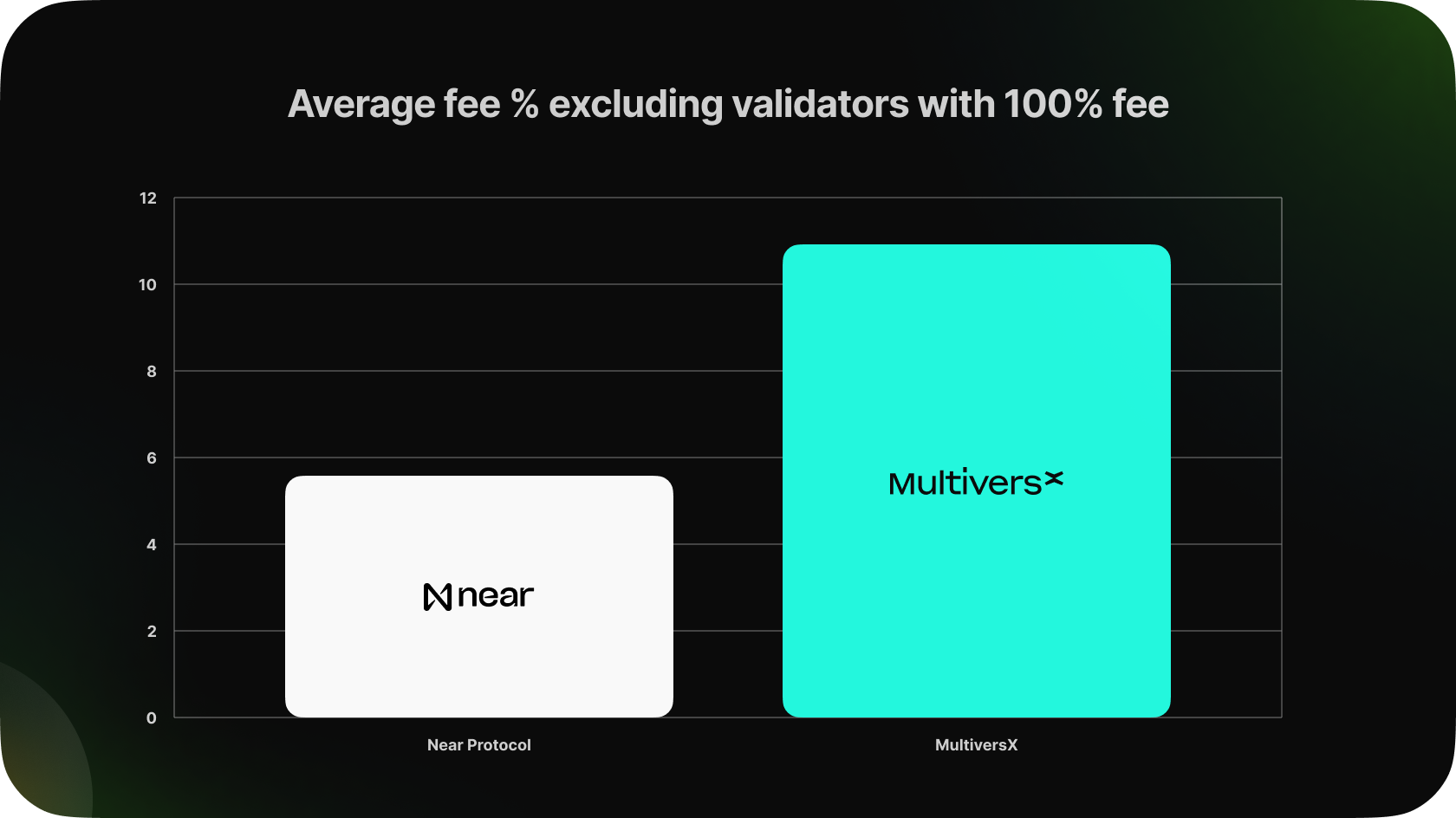
As we can gather from the official explorers, most of the heavily staked validators charge 15% fee or higher. This makes MultiversX attractive even for small validators looking to survive the severe bear market conditions.
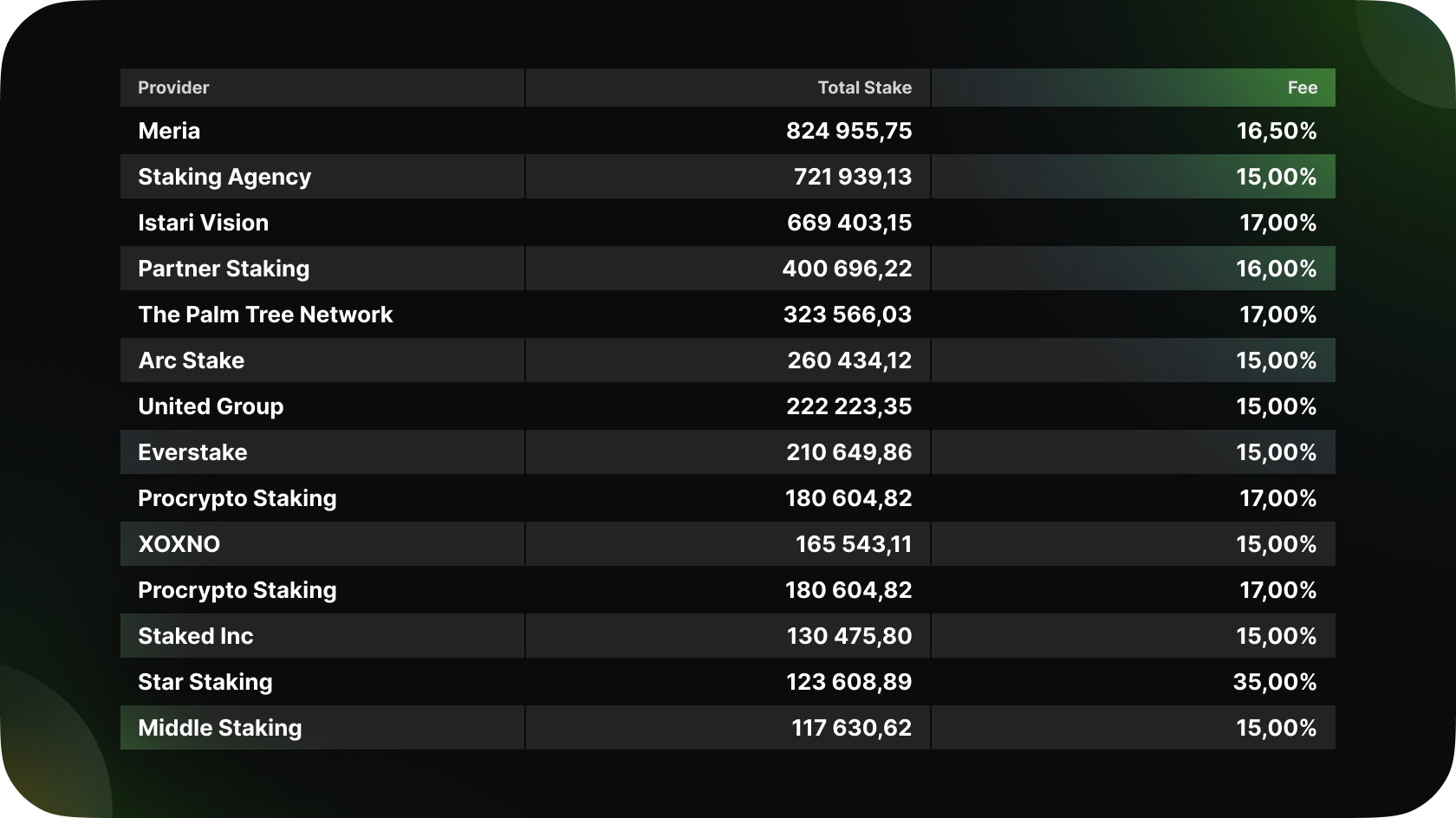
Many validators are also big community contributors and work hard on projects alongside the foundation. This is because nodes can currently only be allocated by the foundation or by the "queue". There are currently 79 nodes in the queue waiting to join the active set. During this period, they use stake but do not generate any profit. This queue can take several months due to high demand and a fixed number of nodes. This explains why white-label node services are not widely distributed.
In short, the interest in staking is consistently rising among MultiversX users. Due to the fixed number of nodes, there is high demand for each staking provider, and they can therefore charge higher fees. It is also worth noting that validating in MultiversX requires running multiple nodes instead of just one. Validators typically spend more on infrastructure and engineering teams.
The greater the stake a validator receives, the lower the APR it can offer. This is why institutional clients tend to distribute their stake across multiple validators, rather than heavily focusing on one.
A detailed description of the MultiversX staking model. All the possible ways to maximize the number of rewards
Stake in MultiversX is separated into 2 parts:
• Base stake
• Top-up stake
The base stake is allocated to nodes participating in network validation. The maximum number of nodes that can participate in validation is 3200, and each node must be staked with a minimum of 2,500 EGLDs. Validators can have as many nodes as they want, but there are a few points to keep in mind:
Imagine you have five nodes, all of which participate in the validation process and generate income for you. Your total stake is 12,500 EGLDs. Someone has given you an additional 5,000 EGLDs, which you can use to run two more nodes, increasing your stake to a total of 17,500 EGLDs across seven nodes. However, the maximum capacity of 3,200 nodes in the network is already occupied by nodes of other validators, which means that your two new nodes, with only 5,000 EGLDs each, must wait in a queue before they can begin validation. While they wait in the queue, they do not generate any rewards but still cost to maintain. Unfortunately, the queue moves slowly, and it's possible that you'll have to wait for months because there are other nodes ahead of yours and nodes in the validating pool don't leave very often. What's the solution? The solution is to top-up your stake.
The top-up stake is a type of stake that you can use if you don't have the possibility to run new nodes or wait in a long queue. In the example above, we have 5 nodes with 2,500 EGLDs each, totalling 12,500 EGLDs at stake. We have an extra 5,000 EGLDs of stake, but we can't run new nodes to stake it. In this case, these 5,000 EGLDs will automatically become a Top-up stake. Therefore, we have a total of:
So, what is the difference between Top-up and base stake? The difference lies in the number of rewards that the validator gains for each stake.
You can find all the formulas behind our calculations here:
Genesis Total Supply = 20M EGLDs
inflation Rate = 8.56% (year 3)
P = 2 000 000
Total Nodes = 3 200
Eligible Top Up Stake = 3 863 418,56
Total Top Up Stake = 7 571 288,70
Protocol Sustainability Rewards = 10%
Num Days in A Year = 365
Top-up Factor = 0.5
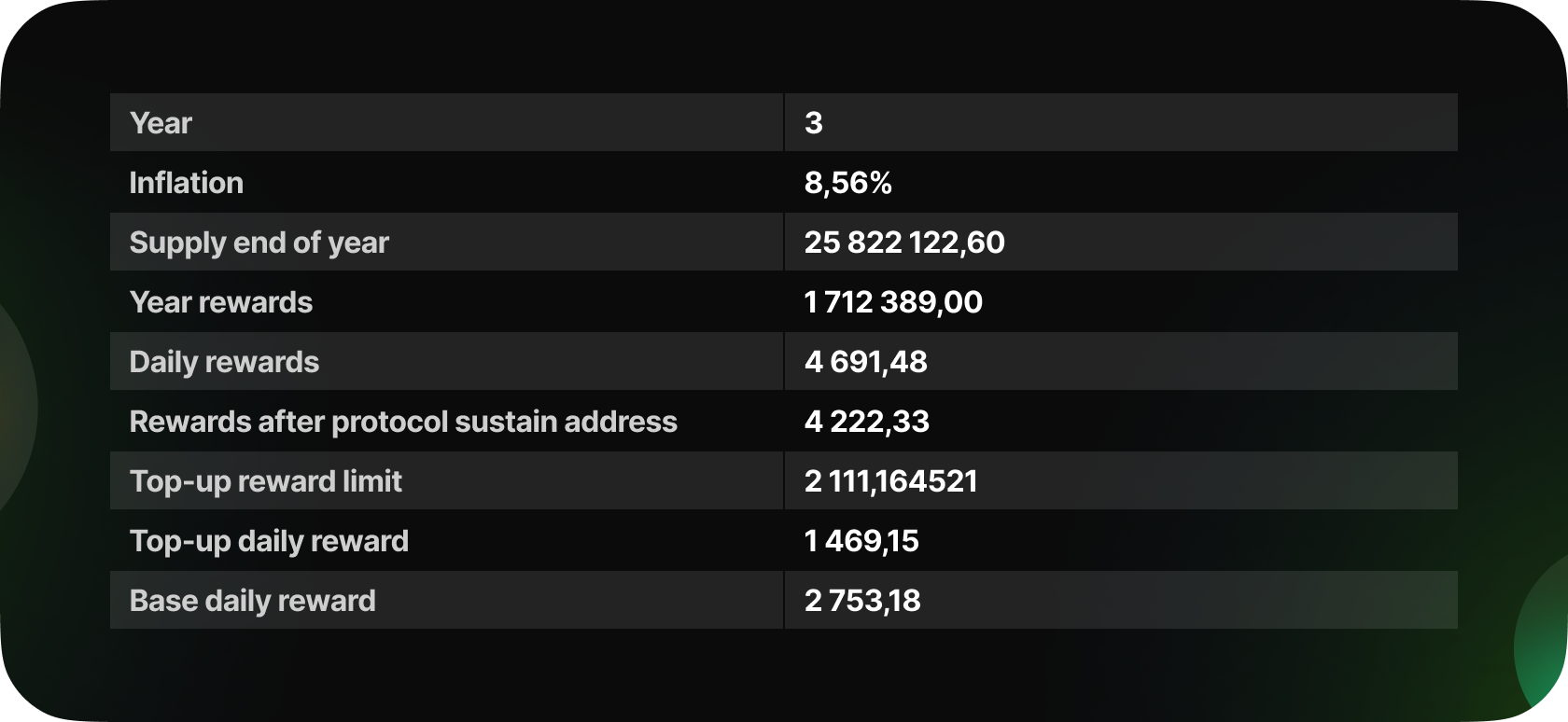
As you can see, there is a reward of 2753 EGLDs for base stake and 1469 EGLDs for Top-up stake. The reward for base stake is twice as large as the reward for Top-up stake, and it will be distributed among validators. To calculate these rewards, use the following formulas:
We can calculate final rewards for an epoch. Let’s consider P2P.ORG and The Palm Tree Network:

The main reason is that The Palm Tree Network's base stake accounts for 58% of their total stake, which is allocated on 76 nodes. On the other hand, P2P.ORG only has 39% of their base stake out of the total. The current APR for each type of stake is as follows:
Reward Base x 365/ Base Stake = 12.5% for base stake
Reward Top-up x 365/ Top-up Stake = 7% for Top-up stake
One key point is the idea that if you have a large amount of base stake, you can charge higher fees to your clients while still providing a good APR. To calculate a client's APR with the real validator fees of P2P at 10% and Palm Tree at 17%, use the following formula:

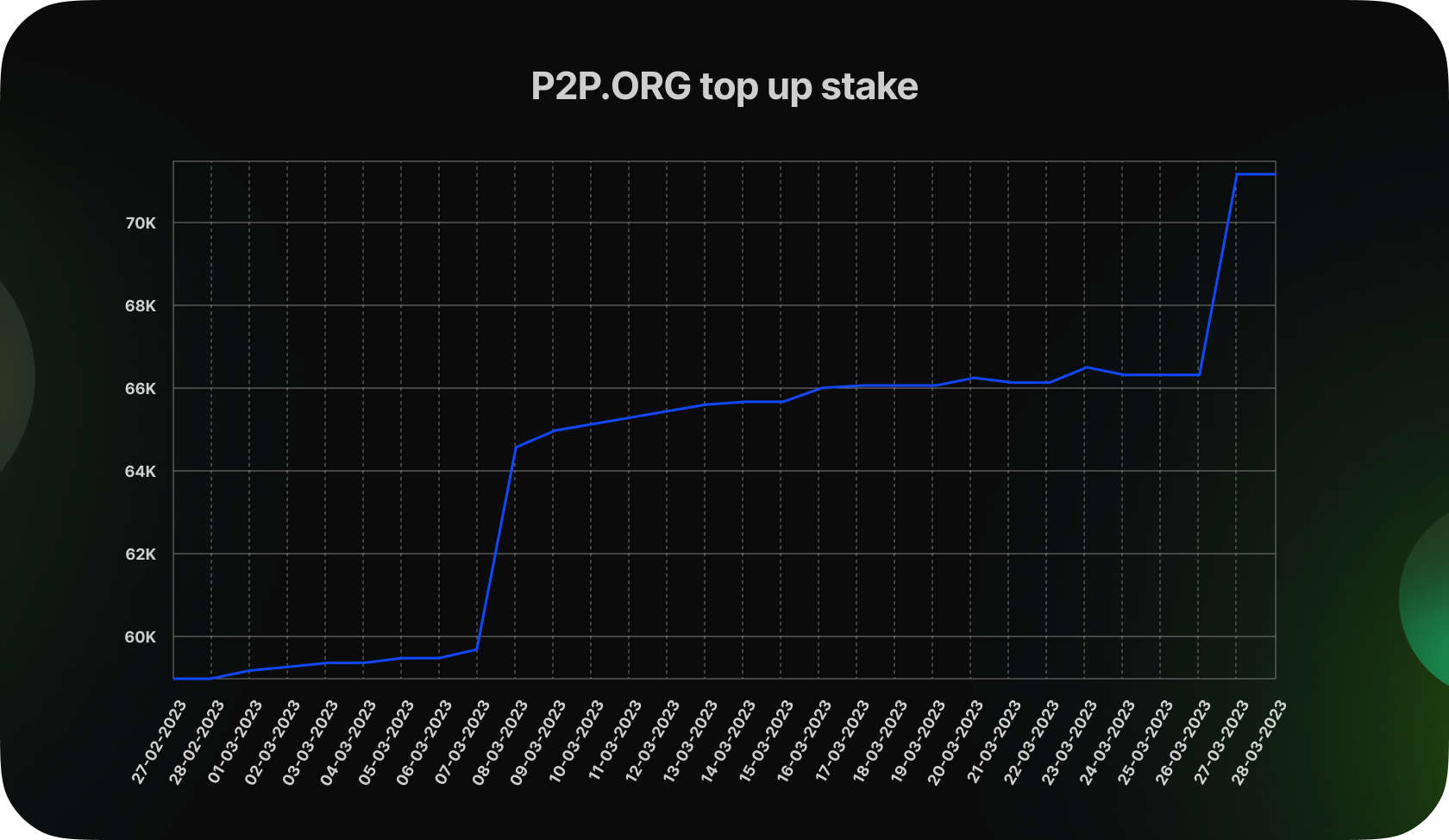
We have been delegated approximately 6,000 EGLDs twice. As a result, our overall stake has increased by almost 10%, while our top-up stake has increased by 20%. Although our TVL and share have both increased and our APR has dropped. The Palm Tree Network, on the other hand, has not experienced any major changes in their stake. They only received an additional 1,500 EGLDs, which is approximately 1% of their top-up stake.
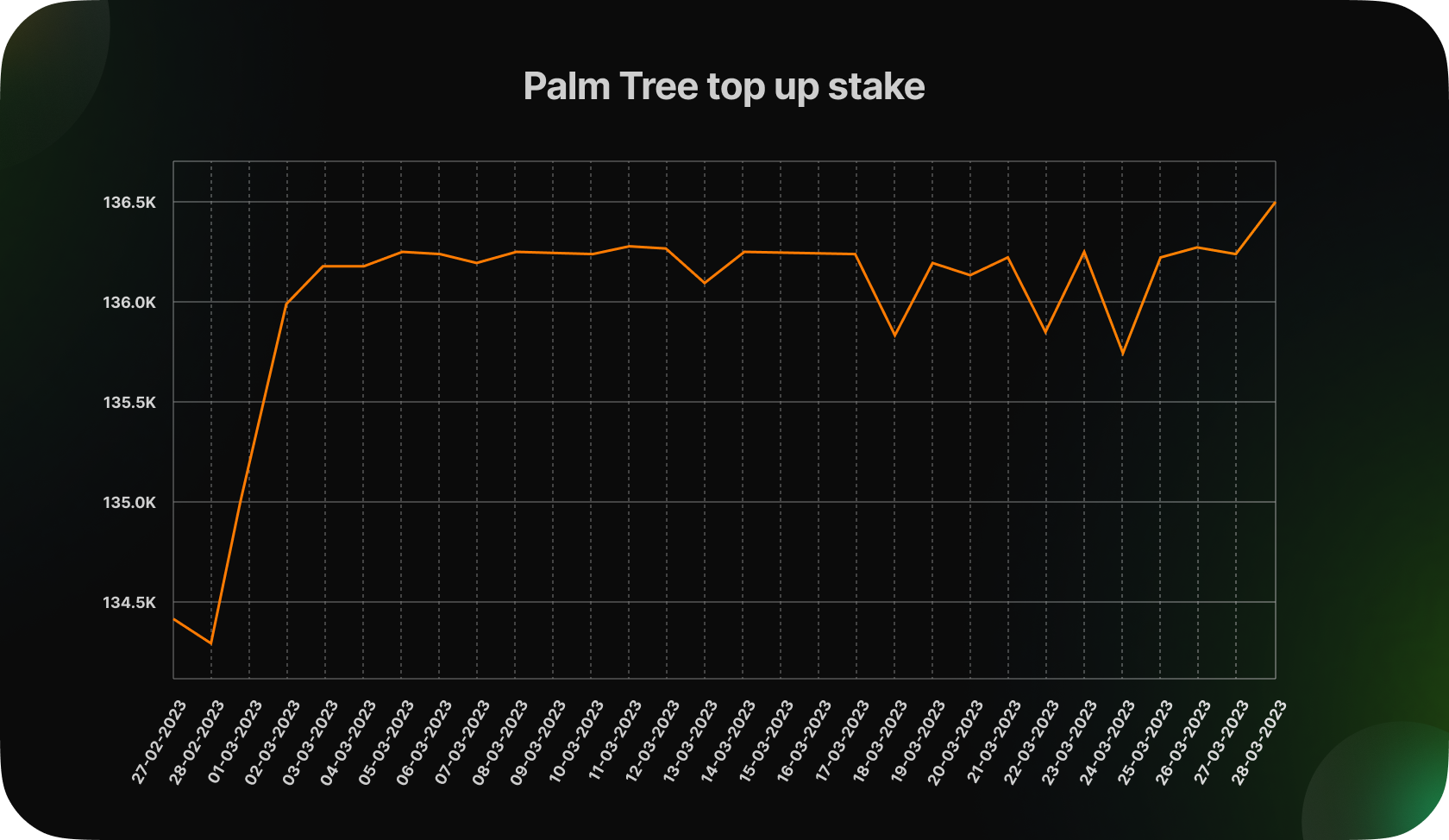
Should a validator increase their Total Value Locked (TVL) if they do not have enough nodes to allocate all stakes? Increasing your Top-up stake may result in a drop in client APR, making you less attractive to potential delegators. However, you must grow your TVL to be profitable or at least cover costs, which is not easy these days. Cryptocurrency prices are not as high as they were a year ago, while infrastructure costs have increased significantly.
After some research, we have found a solution that may seem strange at first, but will ultimately help us work efficiently, cover all costs, and provide a stable service for our delegators. The solution is to raise fees. While raising fees will increase our income, there is a good possibility that our delegators won't lose in the long run.
Initially, after the fee raise, our delegators may lose some of their rewards, and we should expect a churn of delegators and TVL. However, just as new delegations become a top-up stake due to a lack of nodes, in the case of an unstake, the top-up stake goes first. As a result, the share of the base stake increases, and the client's APR starts to grow along with the growth of rewards share for the base stake.
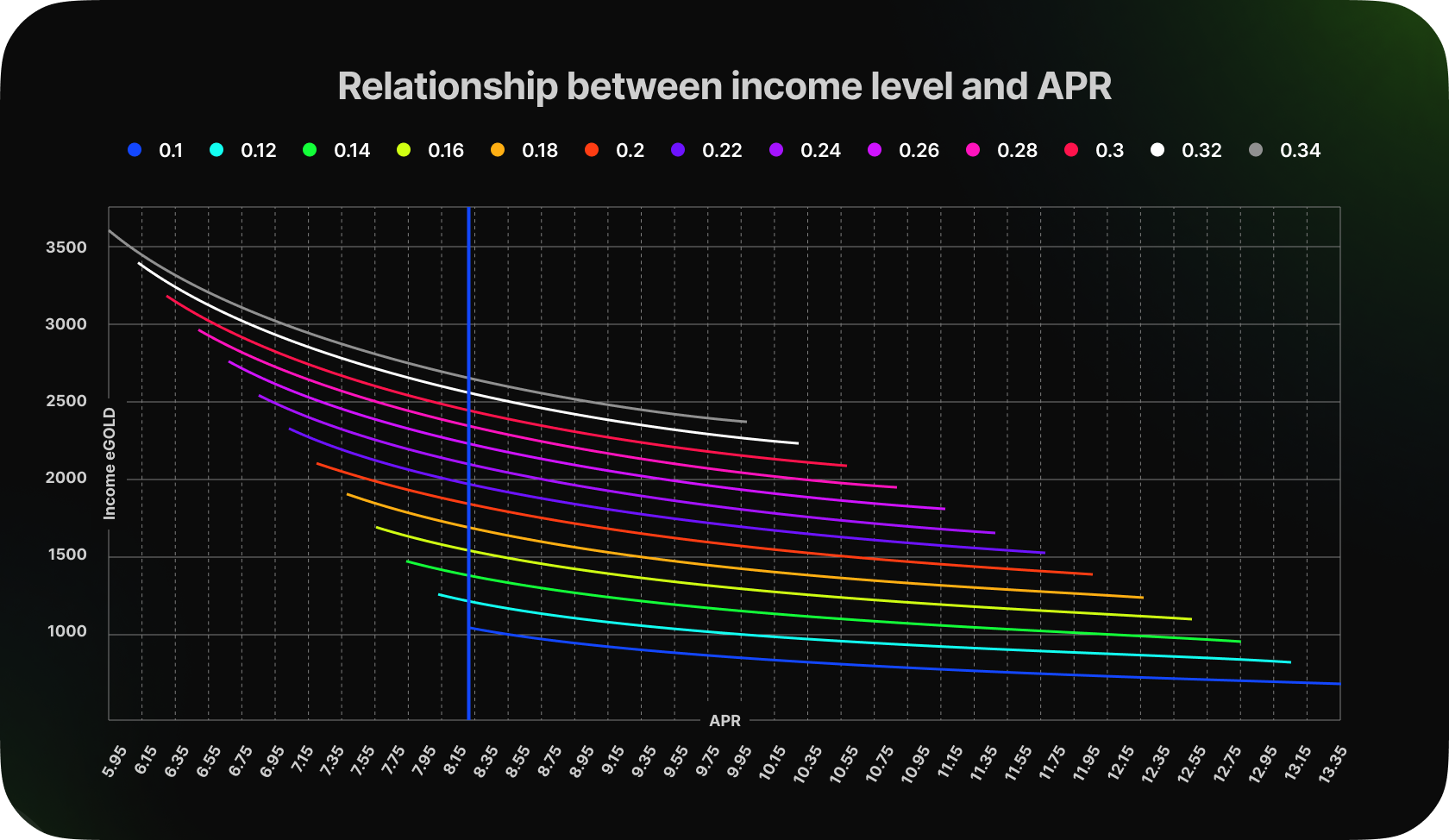
The plot above illustrates how income and APR will change after a fee raise and the next stake churn. The blue vertical line represents our current APR, which is around 8.15%. The lowest blue horizontal curve shows our current state where we have the same fee at 10%, and how income and APR will change if we face churn of stake. Churn will lead us to a situation where our top-up stake and income drops at the same time. However, the client's APR will grow as the share of the base stake grows. The end of the line signals that all top-up stake was unstaked, and we are left only with the base stake. The result is a high client's APR; however, we face a loss of 1/3 of our current income.
All other lines show the same for different fees. The more fees we take, the more income we have. However, it also provides a very low client's APR, and we have to lose a significant amount of our TVL to return to the situation of our current APR.
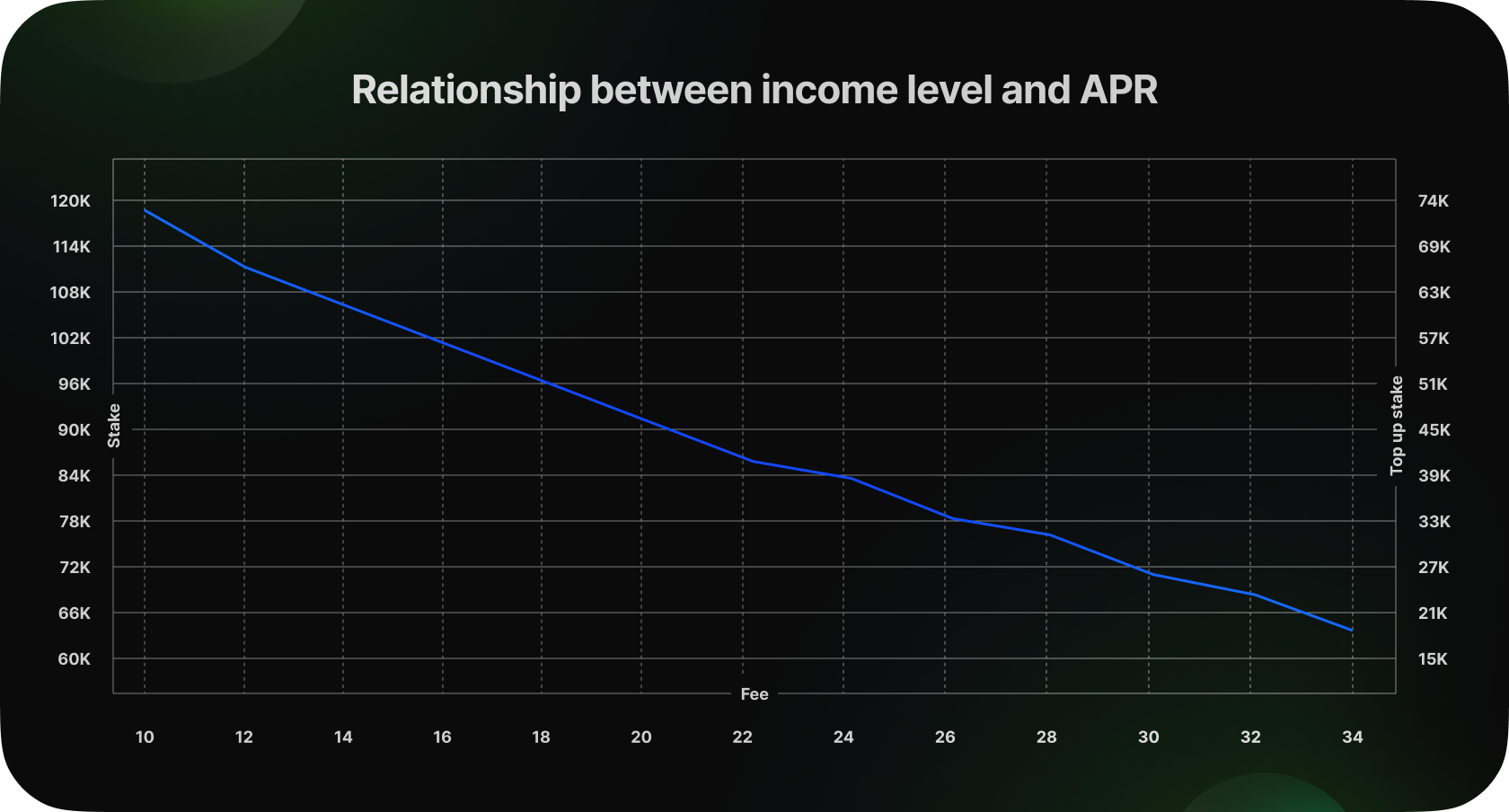
To give you a better understanding of how it works, we have provided a plot above. The blue line indicates the optimal point for the current APR (~8.15%), which depends on stake, top-up stake, and fee. The top point on the blue line represents the current state with a fee of 10%, stake at 116,000 EGLD, and top-up stake near 71,000 EGLD.
If we were to raise the fee to 34-35%, we would need to lose nearly half of our stake (55,000 EGLD) to return to the value of 8.15% for the client's APR. This would occur if our TVL dropped to 62,000 EGLD from 116,000 EGLD, and the share of base stake became nearly 70% (currently only 39%).
However, after some time, the APR will return to its previous values as the share of top-up stake drops.
In the MultiversX network, the amount of staked tokens is rapidly increasing. According to the MultiversX roadmap, liquid staking is coming, which will cause a slight decrease in the average APR across the entire network. It's good that the foundation is not trying to increase the APR, it could affect the stability of the exchange rate and prevent the coin from becoming deflationary.
The next big change in MultiversX is called "Phase 4", in which the queue will be replaced by the auction list. Validators who are shuffled out of the Eligible list will be moved to this auction list, and only the ones with the highest top-up will be further promoted to the waiting list and made eligible. The amount of base stake per node will remain at 2,500 EGLD. Thus, validators will have the intention to attract delegation, making the field more competitive. This might transform validators into builders, while maintaining high margins for validators.
As shown in the previous section, P2P.ORG could be more efficient and save the current APR by reducing the TVL and increasing the fee. On April 25th, P2P.ORG will change the fee to 17% and for a short period of time, the APR will decrease from 8.1% to 7.5%, but we expect growth to the previous values after some time due to the churn of top-up stake.
We want to thank all our delegators for their continuous support and for staking with us!
<p>We are excited to introduce our ground-breaking Ethereum (ETH) auto-staking feature, powered by our <a href="https://github.com/mixbytes/audits_public/tree/master/P2P.org?ref=p2p.org" rel="noopener noreferrer">audited immutable smart contract</a>. This feature completely automates the Ethereum staking process, making staking ETH easier than ever.</p><p>Our ETH staking offer is completely non-custodial and there are no KYC requirements. You simply connect your wallet and stake. </p><p>To set up a validator you will only need:</p><p>1) An Ethereum wallet</p><p>2) To specify the amount of stake - 1 validator per 32 ETH;</p><p>3) To specify the withdrawal address.</p><h2 id="ethereum-staking-guide">Ethereum Staking guide</h2><ol><li>Navigate to <a href="https://eth.p2p.org/?ref=p2p.org">https://eth.p2p.org/</a> and you will be brought up to the screen below.</li></ol><figure class="kg-card kg-image-card"><img src="https://p2p.org/economy/content/images/2023/04/image.png" class="kg-image" alt loading="lazy" width="1440" height="811" srcset="https://p2p.org/economy/content/images/size/w600/2023/04/image.png 600w, https://p2p.org/economy/content/images/size/w1000/2023/04/image.png 1000w, https://p2p.org/economy/content/images/2023/04/image.png 1440w" sizes="(min-width: 720px) 720px"></figure><p>2. Then click "connect wallet" on the top right. We currently support Metamask and Ledger Wallet or you can use Wallet Connect. </p><figure class="kg-card kg-image-card"><img src="https://p2p.org/economy/content/images/2023/04/image-4.png" class="kg-image" alt loading="lazy" width="1440" height="802" srcset="https://p2p.org/economy/content/images/size/w600/2023/04/image-4.png 600w, https://p2p.org/economy/content/images/size/w1000/2023/04/image-4.png 1000w, https://p2p.org/economy/content/images/2023/04/image-4.png 1440w" sizes="(min-width: 720px) 720px"></figure><p>We have prepared a video guide on how to connect a Safe wallet:</p><figure class="kg-card kg-video-card"><div class="kg-video-container"><video src="https://p2p.org/economy/content/media/2023/04/howto-eth-p2p-stake.mp4" poster="https://img.spacergif.org/v1/1920x1080/0a/spacer.png" width="1920" height="1080" playsinline preload="metadata" style="background: transparent url('https://p2p.org/economy/content/images/2023/04/media-thumbnail-ember2702.jpg') 50% 50% / cover no-repeat;" /></video><div class="kg-video-overlay"><button class="kg-video-large-play-icon"><svg xmlns="http://www.w3.org/2000/svg" viewBox="0 0 24 24"><path d="M23.14 10.608 2.253.164A1.559 1.559 0 0 0 0 1.557v20.887a1.558 1.558 0 0 0 2.253 1.392L23.14 13.393a1.557 1.557 0 0 0 0-2.785Z"/></svg></button></div><div class="kg-video-player-container"><div class="kg-video-player"><button class="kg-video-play-icon"><svg xmlns="http://www.w3.org/2000/svg" viewBox="0 0 24 24"><path d="M23.14 10.608 2.253.164A1.559 1.559 0 0 0 0 1.557v20.887a1.558 1.558 0 0 0 2.253 1.392L23.14 13.393a1.557 1.557 0 0 0 0-2.785Z"/></svg></button><button class="kg-video-pause-icon kg-video-hide"><svg xmlns="http://www.w3.org/2000/svg" viewBox="0 0 24 24"><rect x="3" y="1" width="7" height="22" rx="1.5" ry="1.5"/><rect x="14" y="1" width="7" height="22" rx="1.5" ry="1.5"/></svg></button><span class="kg-video-current-time">0:00</span><div class="kg-video-time">/<span class="kg-video-duration"></span></div><input type="range" class="kg-video-seek-slider" max="100" value="0"><button class="kg-video-playback-rate">1×</button><button class="kg-video-unmute-icon"><svg xmlns="http://www.w3.org/2000/svg" viewBox="0 0 24 24"><path d="M15.189 2.021a9.728 9.728 0 0 0-7.924 4.85.249.249 0 0 1-.221.133H5.25a3 3 0 0 0-3 3v2a3 3 0 0 0 3 3h1.794a.249.249 0 0 1 .221.133 9.73 9.73 0 0 0 7.924 4.85h.06a1 1 0 0 0 1-1V3.02a1 1 0 0 0-1.06-.998Z"/></svg></button><button class="kg-video-mute-icon kg-video-hide"><svg xmlns="http://www.w3.org/2000/svg" viewBox="0 0 24 24"><path d="M16.177 4.3a.248.248 0 0 0 .073-.176v-1.1a1 1 0 0 0-1.061-1 9.728 9.728 0 0 0-7.924 4.85.249.249 0 0 1-.221.133H5.25a3 3 0 0 0-3 3v2a3 3 0 0 0 3 3h.114a.251.251 0 0 0 .177-.073ZM23.707 1.706A1 1 0 0 0 22.293.292l-22 22a1 1 0 0 0 0 1.414l.009.009a1 1 0 0 0 1.405-.009l6.63-6.631A.251.251 0 0 1 8.515 17a.245.245 0 0 1 .177.075 10.081 10.081 0 0 0 6.5 2.92 1 1 0 0 0 1.061-1V9.266a.247.247 0 0 1 .073-.176Z"/></svg></button><input type="range" class="kg-video-volume-slider" max="100" value="100"></div></div></div></figure><p>3. Once you successfully connect your wallet, we can begin the staking process. We can define how much ETH we want to stake and a withdrawal address.</p><p>Each Ethereum validator requires 32 ETH to set up so Ethereum can only be staked in multiples of 32 ETH. <br><br>We can also pick a different withdrawal address. The withdrawal address is used to receive rewards and withdraw the ETH staked.</p><figure class="kg-card kg-image-card"><img src="https://p2p.org/economy/content/images/2023/04/image-6.png" class="kg-image" alt loading="lazy" width="1440" height="759" srcset="https://p2p.org/economy/content/images/size/w600/2023/04/image-6.png 600w, https://p2p.org/economy/content/images/size/w1000/2023/04/image-6.png 1000w, https://p2p.org/economy/content/images/2023/04/image-6.png 1440w" sizes="(min-width: 720px) 720px"></figure><p>4. Once everything is set up, we can press continue and we will be taken to a confirmation screen. If everything is set up correctly we can press Stake. </p><figure class="kg-card kg-image-card"><img src="https://p2p.org/economy/content/images/2023/04/image-7.png" class="kg-image" alt loading="lazy" width="1440" height="868" srcset="https://p2p.org/economy/content/images/size/w600/2023/04/image-7.png 600w, https://p2p.org/economy/content/images/size/w1000/2023/04/image-7.png 1000w, https://p2p.org/economy/content/images/2023/04/image-7.png 1440w" sizes="(min-width: 720px) 720px"></figure><p>5. You will be prompted to confirm the transaction on your wallet.</p><figure class="kg-card kg-image-card"><img src="https://p2p.org/economy/content/images/2023/04/image-8.png" class="kg-image" alt loading="lazy" width="1440" height="966" srcset="https://p2p.org/economy/content/images/size/w600/2023/04/image-8.png 600w, https://p2p.org/economy/content/images/size/w1000/2023/04/image-8.png 1000w, https://p2p.org/economy/content/images/2023/04/image-8.png 1440w" sizes="(min-width: 720px) 720px"></figure><p>6. After you confirm the transaction in your wallet, wait a few minutes for it to be completed in the network.</p><figure class="kg-card kg-image-card"><img src="https://p2p.org/economy/content/images/2023/04/image-9.png" class="kg-image" alt loading="lazy" width="1440" height="966" srcset="https://p2p.org/economy/content/images/size/w600/2023/04/image-9.png 600w, https://p2p.org/economy/content/images/size/w1000/2023/04/image-9.png 1000w, https://p2p.org/economy/content/images/2023/04/image-9.png 1440w" sizes="(min-width: 720px) 720px"></figure><p>7. Once the transaction has been successfully confirmed we need to wait for the validators to become active. Under normal circumstances can take up to 24 hours but this is subject to change based on the number of people trying to stake.</p><p>While you wait you can join a personal telegram chat with our team. There we will share updates about your stake and can answer all of your questions.</p><figure class="kg-card kg-image-card"><img src="https://p2p.org/economy/content/images/2023/04/image-10.png" class="kg-image" alt loading="lazy" width="1440" height="1118" srcset="https://p2p.org/economy/content/images/size/w600/2023/04/image-10.png 600w, https://p2p.org/economy/content/images/size/w1000/2023/04/image-10.png 1000w, https://p2p.org/economy/content/images/2023/04/image-10.png 1440w" sizes="(min-width: 720px) 720px"></figure><p>8. Once the validators are active you will start earning rewards. You will also have access to a personal dashboard where you can check the status of your staked account. </p><figure class="kg-card kg-image-card"><img src="https://p2p.org/economy/content/images/2023/04/image-11.png" class="kg-image" alt loading="lazy" width="1440" height="1072" srcset="https://p2p.org/economy/content/images/size/w600/2023/04/image-11.png 600w, https://p2p.org/economy/content/images/size/w1000/2023/04/image-11.png 1000w, https://p2p.org/economy/content/images/2023/04/image-11.png 1440w" sizes="(min-width: 720px) 720px"></figure><hr><!--kg-card-begin: markdown--><h2 id="ethereum-eth-staking-faq">Ethereum (ETH) Staking FAQ</h2> <h3 id="do-i-need-to-pass-kyc-to-stake-eth">Do I need to pass KYC to stake ETH?</h3> <p>No, when working with P2P, there is no need to go through KYC because staked assets never touch our account and are sent directly to the Ethereum network.</p> <h3 id="what-is-the-minimum-amount-of-ethereum-required-to-stake">What is the minimum amount of Ethereum required to stake?</h3> <p>No Ethereum is necessary to run a node. However, it is necessary to stake 32 ETH x [amount of validators] to activate the validators and start getting rewards.</p> <h3 id="what-is-a-withdrawal-address-and-who-owns-it">What is a withdrawal address, and who owns it?</h3> <p>The withdrawal address is the Ethereum address used to unstake and receive rewards. This address is specified once and it can't be changed after the staking deposit is sent, because the network cements the association of a particular validator and withdrawal address. Access to the private key for this withdrawal address is required to unstake (seed phrase). It is also important to note that P2P is not a custodian and has no exposure to the client’s withdrawal private key. P2P will never ask, under any circumstance, at any time for access to the withdrawal key.</p> <h3 id="what-is-a-validator-key-and-who-owns-it">What is a validator key, and who owns it?</h3> <p>A validator key is a private key for maintaining the validator’s work (setting up validators, updating software etc.). P2P owns the validator keys and guarantees the highest standards for protecting these keys from being compromised, breached, or otherwise misused. This is accomplished through Threshold signatures, which are the gold standard for internal/external security threats. This solution is used by leading custodians, crypto banks, and Multi-Party Computation solutions.</p> <h3 id="why-use-smart-contracts-to-stake-eth">Why use smart contracts to stake ETH?</h3> <p>By design, ETH staking requires one staking transaction per 32 ETH. By using smart contracts we significantly simplify staking, reduce the cost of staking and minimize the risk of any human error. Thanks to our <a href="https://github.com/mixbytes/audits_public/tree/master/P2P.org?ref=p2p.org">audited</a> smart contracts it is possible to activate up to 100 validators with a single transaction.</p> <h3 id="can-i-stake-ethereum-with-a-hardware-wallet">Can I stake Ethereum with a hardware wallet?</h3> <p>Yes, it is possible to stake ETH with a Ledger (via native connection) or a Trezor wallet (via Metamask).</p> <h3 id="how-do-i-earn-rewards-from-staking-ethereum">How do I earn rewards from staking Ethereum?</h3> <p>Ethereum rewards are comprised of 2 parts associated with performing validation duties and block creation.</p> <ol> <li>Validation rewards are taken by performing the validator’s duties as an attestation for a block created by another validator, attestation for a block in sync committee and for creating a block. Validation rewards are accrued every 6.4 min and account for around 70% of the total rewards. Currently, these rewards aren’t withdrawable until the Shanghai upgrade. Following Shanghai, it will be possible to:</li> </ol> <ul> <li>Fully withdraw all the staked ETH + rewards and deactivate the validator;</li> <li>Partially withdraw all the Ethereum over 32 to the withdrawal address periodically.</li> </ul> <ol start="2"> <li>Block rewards (priority transaction fees + an additional fee from MEV) are accrued with block creation as a payment from transactions to the validator for including them in the block. It appears once every 62 days on average and accounts for around 30% of the total reward. MEV-boost isn’t a separate type of reward but is a technique used to build a block that will yield the maximum fee. Transaction fees accumulate on a p2p smart contract which is then automatically delivered to the client on a monthly basis after the P2P service fee has been deducted.</li> </ol> <h3 id="can-i-still-use-my-staked-ethereum-while-it-is-staked">Can I still use my staked Ethereum while it is staked?</h3> <p>No, the staked ETH is locked in the Ethereum smart contract and cannot be used.</p> <h3 id="how-does-p2p-take-its-service-fee">How does P2P take its service fee?</h3> <p>P2P takes its service fee from the execution layer rewards. By default, a special immutable smart contract is used to automatically split rewards between the user and P2P by the previously agreed rules. Other invoicing strategies can be employed by prior agreement.</p> <h3 id="how-does-slashing-work-in-ethereum">How does slashing work in Ethereum?</h3> <p>Slashing punishes validators for actions that are very difficult to do accidentally, and it’s very likely a sign of malicious intent. It’s a really rare event: there's only been 5 slashed validators within the whole network over the last month (or 0.001%). <a href="https://beaconcha.in/validators/slashings?ref=p2p.org">beaconcha.in/validators/slashings</a></p> <p>What is “slashable” behaviour? In a nutshell, it’s a violation of consensus rules in the network. As of right now, it needs to meet three conditions: proposal of two conflicting blocks at the same time, double vote attestation and surround attestation. This can happen due to either an intentional malicious action or misconfiguration of the validator (the most often being, running two of the same validators in the network).</p> <p>Slashing results in burning 1,0 ETH at once, and removing the validator from the network forever, which takes 36 days. During this time, the validator continues to work but can no longer participate in validation and block creation, getting a penalty of around 0.1 ETH in total.</p> <p>For the most part that's the sum of the penalty incurred, but there is also an additional midpoint (Day 18) penalty that scales with the number of slashed validators. This is called "correlation penalty” and it's currently only theoretical and has never been encountered on the Ethereum mainnet. This mechanism is there to protect the network from large attacks. The math for calculation penalty is pretty complicated, but the summary is if there are only 1, 100, or even 1000 slashed validators within 36 days the penalty will equal zero ETH. However, if the number of slashed validators increases to roughly 1.1% of all validators (currently 5.1k), this penalty becomes 1 ETH and an additional 1 ETH for every additional 1.1% validator slashed. So if 1/3 of the network is slashed, the penalty will nullify the whole stake (32 ETH). This mechanism is in place to prevent an attack on the network and it should never be triggered by accident.</p> <h3 id="how-can-slashing-be-prevented">How can slashing be prevented?</h3> <p>There are special mechanisms in place to prevent validators from meeting the slashing conditions called <a href="https://medium.com/prysmatic-labs/eth2-slashing-prevention-tips-f6faa5025f50?ref=p2p.org">slashing protection</a>. These mechanisms usually consist of a database with a signing history which the validator uses to check if the block can be signed (coupled with the default levels of monitoring and alerting protection). Additional protection levels will depend on the validator’s setup. P2P uses double-checking with a separate database at the key-manager stage and secures validators' key’s by Threshold, which means that no single person, even a P2P engineer, can run a second validator and a quorum is required for that. The final level of protection we have in place is an institutional grade slashing insurance.</p> <h3 id="how-can-staking-activity-be-tracked">How can staking activity be tracked?</h3> <p>Anyone who stakes with P2P gets access to a personal staking dashboard that can be used to track rewards and the validators' performance (APR, staking balance, % of blocks created with MEV, attestation rate, missed block, market comparisons, etc.)</p> <h3 id="in-what-geographic-location-is-p2ps-validator-infrastructure-running">In what geographic location is P2P's validator infrastructure running?</h3> <p>P2P direct staking infrastructure is located in Europe and distributed among 5 separate physical locations for protection from downtime.</p> <h3 id="how-does-p2p-protect-its-validators-from-widespread-outages">How does P2P protect its validators from widespread outages?</h3> <p>P2P validators have no single point of failure and are downtime resistant with back-ups of all critical infrastructure parts between 5 different physical locations, including:</p> <ol> <li> <p>Signing infrastructure - 3 location-independent key managers with 2-of-3 threshold quorum required for consensus;</p> </li> <li> <p>Validators Nodes - we have a reserve in a secure region ready to be activated within a maximum of 1 minute in case of an outage;</p> </li> <li> <p>Consensus layer nodes - our setup has top-3 consensus layer clients (Lighthouse, Prysm, Teku) simultaneously for diversity and preventing outrages related to soft bugs in one client. It also increases availability for validators.</p> </li> </ol> <!--kg-card-end: markdown-->
from p2p validator
<h3 id="introducing-our-ethereum-staking-dapp-empowering-users-with-complete-privacy-unmatched-simplicity-ultimate-security-and-zero-fees">Introducing our Ethereum Staking dApp, empowering users with complete privacy, unmatched simplicity, ultimate security and zero fees</h3><p></p><p>We are thrilled to announce the launch of our Ethereum Staking dApp, which is designed to give you the ultimate control over your crypto assets while ensuring complete privacy, autonomy, and security. We have been working diligently behind the scenes to bring you a solution that simplifies the staking process without compromising your privacy.</p><figure class="kg-card kg-image-card"><img src="https://p2p.org/economy/content/images/2023/04/image-12.png" class="kg-image" alt loading="lazy" width="670" height="724" srcset="https://p2p.org/economy/content/images/size/w600/2023/04/image-12.png 600w, https://p2p.org/economy/content/images/2023/04/image-12.png 670w"></figure><h1 id="staking-dapp-key-features"><strong>Staking dApp Key Features</strong></h1><ol><li><strong>Bunker Security Staking & 100% Slashing Protection</strong>: We understand the importance of security for our users, so we have built an infrastructure with no single point of failure. Our geographically distributed data centres with hot reserves in different countries ensure that your validators will keep working even in worst-case scenarios such as a data centre burning down. Moreover, we have implemented threshold cryptography (similar to multisig) to secure your validator keys. This advanced technology ensures that nobody, not even our P2P engineers, can access your validator keys, thereby adding additional protection against slashing incidents. Furthermore, our Staking dApp offers 100% slashing protection options for a truly worry-free staking experience.</li><li><strong>Stake with just a few clicks</strong>: Really, no human input is needed! Our Staking dApp automates the entire staking process, eliminating the need for human intervention. Our dApp is built on smart contracts, offering a transparent, trustless, and tamper-proof solution for staking your Ethereum assets. Additionally, our Staking dApp allows clients to stake directly from our website with just a few clicks, ensuring an effortless experience without the need for any technical know-how.</li><li><strong>No KYC</strong>: Our dApp ensures that you can stake your Ethereum assets without having to go through the cumbersome KYC (Know Your Customer) process. We respect your right to privacy and offer a seamless user experience without any unnecessary roadblocks.</li><li><strong>No Email Registration</strong>: With our Staking dApp, you no longer need to share your email address to stake your crypto. Just access the dApp through your preferred web3-enabled wallet, and you are ready to stake.</li><li><strong>No AML Risks</strong>: We have designed our Staking dApp to comply with all relevant regulations, mitigating any AML (Anti-Money Laundering) risks while ensuring that your Ethereum staking experience is secure and reliable.</li></ol><h2 id="how-does-it-work">How does it work?</h2><p>By automating the staking process, we have created a permissionless dApp that is both user-friendly and highly secure.</p><p>If you have ever tried to delegate your stake to a staking provider, you are already familiar with the multi-step flow of selecting the amount to stake, setting your withdrawal address, entering an email address, and then… receiving an email from a sales representative for an intro call.</p><p>While we understand the reasoning behind it (we have used a similar flow till now), the improvement opportunities in terms of user experience are massive.</p><p>That’s why, when you stake with our staking dashboard, you can expect to complete the request in just a few clicks:</p><ul><li>Enter the amount to stake and the withdrawable address</li><li>Check your staking details and stake the requested amount</li></ul><figure class="kg-card kg-image-card"><img src="https://p2p.org/economy/content/images/2023/04/image-13.png" class="kg-image" alt loading="lazy" width="670" height="785" srcset="https://p2p.org/economy/content/images/size/w600/2023/04/image-13.png 600w, https://p2p.org/economy/content/images/2023/04/image-13.png 670w"></figure><ul><li>Sign a transaction with your favourite wallet provider</li><li>Wait for the transaction to be broadcasted to the Ethereum network</li></ul><figure class="kg-card kg-image-card"><img src="https://p2p.org/economy/content/images/2023/04/image-14.png" class="kg-image" alt loading="lazy" width="670" height="868" srcset="https://p2p.org/economy/content/images/size/w600/2023/04/image-14.png 600w, https://p2p.org/economy/content/images/2023/04/image-14.png 670w"></figure><ul><li>The request is successfully sent!</li></ul><p>After receiving the request, your validators will be added to the Ethereum entry queue before becoming active (the amount of time depends on the network congestion).<br><br>For those of you that have a Safe wallet, we prepared a guide on how to use it with the dApp.</p><figure class="kg-card kg-video-card"><div class="kg-video-container"><video src="https://p2p.org/economy/content/media/2023/04/howto-eth-p2p-stake-1.mp4" poster="https://img.spacergif.org/v1/1920x1080/0a/spacer.png" width="1920" height="1080" playsinline preload="metadata" style="background: transparent url('https://p2p.org/economy/content/images/2023/04/media-thumbnail-ember272.jpg') 50% 50% / cover no-repeat;" /></video><div class="kg-video-overlay"><button class="kg-video-large-play-icon"><svg xmlns="http://www.w3.org/2000/svg" viewBox="0 0 24 24"><path d="M23.14 10.608 2.253.164A1.559 1.559 0 0 0 0 1.557v20.887a1.558 1.558 0 0 0 2.253 1.392L23.14 13.393a1.557 1.557 0 0 0 0-2.785Z"/></svg></button></div><div class="kg-video-player-container"><div class="kg-video-player"><button class="kg-video-play-icon"><svg xmlns="http://www.w3.org/2000/svg" viewBox="0 0 24 24"><path d="M23.14 10.608 2.253.164A1.559 1.559 0 0 0 0 1.557v20.887a1.558 1.558 0 0 0 2.253 1.392L23.14 13.393a1.557 1.557 0 0 0 0-2.785Z"/></svg></button><button class="kg-video-pause-icon kg-video-hide"><svg xmlns="http://www.w3.org/2000/svg" viewBox="0 0 24 24"><rect x="3" y="1" width="7" height="22" rx="1.5" ry="1.5"/><rect x="14" y="1" width="7" height="22" rx="1.5" ry="1.5"/></svg></button><span class="kg-video-current-time">0:00</span><div class="kg-video-time">/<span class="kg-video-duration"></span></div><input type="range" class="kg-video-seek-slider" max="100" value="0"><button class="kg-video-playback-rate">1×</button><button class="kg-video-unmute-icon"><svg xmlns="http://www.w3.org/2000/svg" viewBox="0 0 24 24"><path d="M15.189 2.021a9.728 9.728 0 0 0-7.924 4.85.249.249 0 0 1-.221.133H5.25a3 3 0 0 0-3 3v2a3 3 0 0 0 3 3h1.794a.249.249 0 0 1 .221.133 9.73 9.73 0 0 0 7.924 4.85h.06a1 1 0 0 0 1-1V3.02a1 1 0 0 0-1.06-.998Z"/></svg></button><button class="kg-video-mute-icon kg-video-hide"><svg xmlns="http://www.w3.org/2000/svg" viewBox="0 0 24 24"><path d="M16.177 4.3a.248.248 0 0 0 .073-.176v-1.1a1 1 0 0 0-1.061-1 9.728 9.728 0 0 0-7.924 4.85.249.249 0 0 1-.221.133H5.25a3 3 0 0 0-3 3v2a3 3 0 0 0 3 3h.114a.251.251 0 0 0 .177-.073ZM23.707 1.706A1 1 0 0 0 22.293.292l-22 22a1 1 0 0 0 0 1.414l.009.009a1 1 0 0 0 1.405-.009l6.63-6.631A.251.251 0 0 1 8.515 17a.245.245 0 0 1 .177.075 10.081 10.081 0 0 0 6.5 2.92 1 1 0 0 0 1.061-1V9.266a.247.247 0 0 1 .073-.176Z"/></svg></button><input type="range" class="kg-video-volume-slider" max="100" value="100"></div></div></div></figure><h2 id="free-test-drive-offer">Free Test-drive offer</h2><p>To celebrate the launch of our Staking dApp and the upcoming Shanghai upgrade, we are offering a limited-time promotional period with 0% validator fees until August 1, 2023. This means you can enjoy maximum returns on your staked Ethereum with absolutely no fees.</p><p>And there's more! We have not forgotten our loyal existing clients. If you are a current client and decide to add additional stakes to your account, you will also benefit from the 0% fee promotion. This is our way of thanking you for your continued support and trust in our platform.</p><p>In conclusion, our Ethereum Staking dApp is here to revolutionize the staking experience for Ethereum users. Our commitment to privacy, autonomy, security, and innovation is at the core of our product. We invite you to try out our Staking dApp and join us in this exciting journey towards a decentralized and empowered future.</p><p>If you have any questions or need assistance, please reach out to our BD team! Happy staking, and welcome to the future of Ethereum staking!</p><div class="kg-card kg-button-card kg-align-center"><a href="https://ethereum-staking.p2p.org/?ref=p2p.org" class="kg-btn kg-btn-accent">Stake now</a></div>
from p2p validator